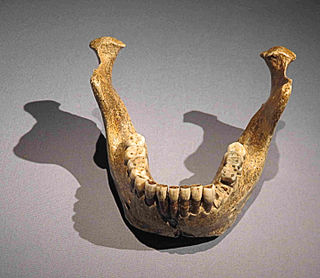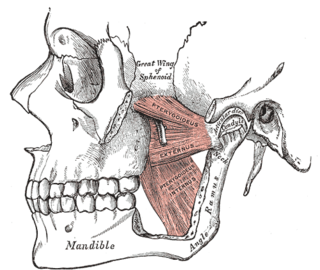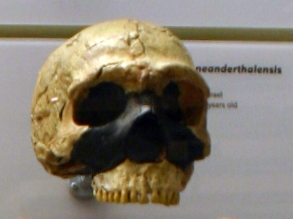
In anatomy, the temporalis muscle, also known as the temporal muscle, is one of the muscles of mastication (chewing). It is a broad, fan-shaped convergent muscle on each side of the head that fills the temporal fossa, superior to the zygomatic arch so it covers much of the temporal bone.Temporal refers to the head's temples.

Homo heidelbergensis is an extinct species or subspecies of archaic human which existed during the Middle Pleistocene. It was subsumed as a subspecies of H. erectus in 1950 as H. e. heidelbergensis, but towards the end of the century, it was more widely classified as its own species. It is debated whether or not to constrain H. heidelbergensis to only Europe or to also include African and Asian specimens, and this is further confounded by the type specimen being a jawbone, because jawbones feature few diagnostic traits and are generally missing among Middle Pleistocene specimens. Thus, it is debated if some of these specimens could be split off into their own species or a subspecies of H. erectus. Because the classification is so disputed, the Middle Pleistocene is often called the "muddle in the middle".

Prognathism, also called Habsburg chin, Habsburg's chin, Habsburg jaw or Habsburg's jaw primarily in the context of its prevalence amongst members of the House of Habsburg, is a positional relationship of the mandible or maxilla to the skeletal base where either of the jaws protrudes beyond a predetermined imaginary line in the coronal plane of the skull. In general dentistry, oral and maxillofacial surgery, and orthodontics, this is assessed clinically or radiographically (cephalometrics). The word prognathism derives from Greek πρό and γνάθος. One or more types of prognathism can result in the common condition of malocclusion, in which an individual's top teeth and lower teeth do not align properly.
Inflammatory papillary hyperplasia (IPH) is a benign lesion of the oral mucosa which is characterized by the growth of one or more nodular lesions, measuring about 2mm or less. The lesion almost exclusively involves the hard palate, and in rare instances, it also has been seen on the mandible. The lesion is mostly asymptomatic and color of the mucosa may vary from pink to red.

In human anatomy, the mandibular canal is a canal within the mandible that contains the inferior alveolar nerve, inferior alveolar artery, and inferior alveolar vein. It runs obliquely downward and forward in the ramus, and then horizontally forward in the body, where it is placed under the alveoli and communicates with them by small openings.

Toothlessness or edentulism is the condition of having no teeth. In organisms that naturally have teeth, it is the result of tooth loss. Organisms that never possessed teeth can also be described as edentulous. Examples are the members of the former zoological classification order of Edentata, which included anteaters and sloths, as they possess no anterior teeth and no or poorly developed posterior teeth.

The chin is the forward pointed part of the anterior mandible below the lower lip. A fully developed human skull has a chin of between 0.7 cm and 1.1 cm.

La Chapelle-aux-Saints 1 is an almost-complete male Neanderthal skeleton discovered in La Chapelle-aux-Saints, France by A. and J. Bouyssonie, and L. Bardon in 1908. The individual was about 40 years of age at the time of his death. He was in bad health, having lost most of his teeth and suffering from bone resorption in the mandible and advanced arthritis.

The Denisovans or Denisova hominins(di-NEE-sə-və) are an extinct species or subspecies of archaic human that ranged across Asia during the Lower and Middle Paleolithic. Denisovans are known from few physical remains; consequently, most of what is known about them comes from DNA evidence. No formal species name has been established pending more complete fossil material.

Neanderthals, also known colloquially as cavemen, are an extinct species or subspecies of archaic humans who lived in Eurasia until about 40,000 years ago. The type specimen, Neanderthal 1, was found in 1856 in the Neander Valley in present-day Germany.

Neanderthal anatomy differed from modern humans in that they had a more robust build and distinctive morphological features, especially on the cranium, which gradually accumulated more derived aspects, particularly in certain isolated geographic regions. This robust build was an effective adaptation for Neanderthals, as they lived in the cold environments of Europe. In which they also had to operate in Europe's dense forest landscape that was extremely different from the environments of the African grassland plains that Homo sapiens adapted to with a different anatomical build.

In jawed vertebrates, the mandible, lower jaw, or jawbone is a bone that makes up the lower – and typically more mobile – component of the mouth.

The pterygomandibular space is a fascial space of the head and neck. It is a potential space in the head and is paired on each side. It is located between the lateral pterygoid muscle and the medial surface of the ramus of the mandible. The pterygomandibular space is one of the four compartments of the masticator space.

Southwest Asian Neanderthals were Neanderthals who lived in Turkey, Lebanon, Syria, Israel, Palestine, Iraq, and Iran - the southernmost expanse of the known Neanderthal range. Although their arrival in Asia is not well-dated, early Neanderthals occupied the region apparently until about 100,000 years ago. At this time, Homo sapiens immigrants seem to have replaced them in one of the first anatomically-modern expansions out of Africa. In their turn, starting around 80,000 years ago, Neanderthals seem to have returned and replaced Homo sapiens in Southwest Asia. They inhabited the region until about 55,000 years ago.

Amud 1 is a nearly complete but poorly preserved adult Southwest Asian Neanderthal skeleton thought to be about 55,000 years old. It was discovered at Amud in Israel by Hisashi Suzuki in July 1961, who described it as male. With an estimated height of 1.78 m, it is considerably taller than any other known Neanderthal, and its skull has by far the largest cranial capacity of any human skull in the fossil record. According to Ralph Holloway, this makes it one of the most famous Neanderthal specimens.
A complete denture is a removable appliance used when all teeth within a jaw have been lost and need to be prosthetically replaced. In contrast to a partial denture, a complete denture is constructed when there are no more teeth left in an arch, hence it is an exclusively tissue-supported prosthesis. A complete denture can be opposed by natural dentition, a partial or complete denture, fixed appliances or, sometimes, soft tissues.

Overdenture is any removable dental prosthesis that covers and rests on one or more remaining natural teeth, the roots of natural teeth, and/or dental implants. It is one of the most practical measures used in preventive dentistry. Overdentures can be either tooth supported or implant supported. It is found to help in the preservation of alveolar bone and delay the process of complete edentulism.

Homo longi is an extinct species of archaic human identified from a nearly complete skull, nicknamed 'Dragon Man', from Harbin on the Northeast China Plain, dating to at minimum 146,000 years ago during the Middle Pleistocene. The skull was discovered in 1933 along the Songhua River while the Dongjiang Bridge was under construction for the Manchukuo National Railway. Due to a tumultuous wartime atmosphere, it was hidden and only brought to paleoanthropologists in 2018. The original describers postulated H. longi represents a member of the Denisovans, though this is unconfirmable without genetic testing. They also considered modern humans to be more closely related to H. longi than to the European Neanderthals, but DNA evidence suggests Denisovans are more closely related to Neanderthals than modern humans.

Mandibular setback surgery is a surgical procedure performed along the occlusal plane to prevent bite opening on the anterior or posterior teeth and retract the lower jaw for both functional and aesthetic effects in patients with mandibular prognathism. It is an orthodontic surgery that is a form of reconstructive plastic surgery. There are three main types of procedures for mandibular setback surgery: Bilateral Sagittal Split Osteotomy (BSSO), Intraoral Vertical Ramus Osteotomy (IVRO) and Extraoral Ramus Osteotomy (EVRO), depending on the magnitude of mandibular setback for each patient. Postoperative care aims to minimise postoperative complications, complications includes bite changes, relapse and nerve injury.
















